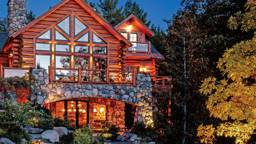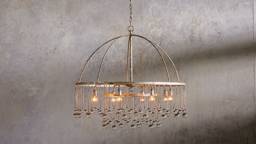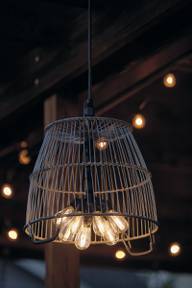
Today’s log homes strive to be energy efficient by incorporating larger overhangs and orienting the house from north to south. These tactics can significantly reduce your heating and cooling bills, but they don’t allow as much natural light to stream through as there would be with an east/west orientation and no overhangs.
And with wood’s tendency to absorb light, there’s always been a drive to bring as much natural illumination into a log home as possible, supplementing with artificial light sources as needed. So to brighten the interior, typically a lot of glass is designed and built into a log structure, especially on gable ends or a prow in the great room/loft. But other areas of the home can benefit from more natural light exposure, too — primarily bedrooms, laundry rooms and, believe it or not, kitchens. By trying to fit enough cabinetry and appliances into a kitchen space, you’d be surprised how often windows are overlooked, making the kitchen rely on a large amount of artificial light and increasing energy usage. As a builder, I’ve helped my clients solve these situations. Here are my top three suggestions to help you build some extra illumination into your log home.
1. Boost Natural Light
In spaces like laundry rooms and master bedrooms, skylights have been a solution that have historically been employed, and we builders still get requests for these today. But they can be expensive, and though there are many reliable brands on the market, home owners often fear they might leak. You can achieve the same effect with solar light tubes. This technology enables you to channel, direct and reflect a significant amount of natural light from a smaller cavity than you’d have with a traditional skylight, and usually at a fraction of the cost. For the best results, install a light tube on the area of your roof that faces southwest and allow the channel to be a straight as possible. Twists and turns in the tube will diminish the light.
When it comes to windows, it’s not as much about size and quantity as it is placement. As you look at your floor plan, identify how your furniture will be arranged and where adding or moving a window might make sense. For instance, having a window above your headboard may be great for reading in bed, but if you have a TV directly opposite, it could cast a harsh glare. A change in elevation, placement or style can remedy the situation. High transom windows in a bathroom can let light stream in while retaining complete privacy. Other options, such as NanaWalls, create an entire wall of glass that can be fully retracted to form a seamless extension between indoors and out. Though they don’t come cheap, they are completely possible to build into a log home, as long as they are engineered and planned for up front.
2. Augment with Smarter Artificial Light
As for artificial overhead light, log homes have historically relied on large cans or imposing track lighting. Now, with LED lighting becoming more readily available and economical, these types of lighting systems can be inconspicuous and require a lot less clearance for installation — a big bonus in a log home with an open-truss roof system, especially in regards to maximizing insulation values. Plus, the new LED options simulate natural light better than the old incandescent variety, the track systems are nearly imperceptible compared to their predecessors and they’re easier to install. Additionally, things like light ropes installed above trim or below a bank of upper cabinets can brighten a space and add ambiance.
3. Don’t Neglect the Great Outdoors
Aside from porch lights or sidelights flanking a front door or garage, many people don’t consider the lighting needs of their outdoor spaces … but they should. Not only will they deepen the enjoyment you’ll get from your home, they will enhance your safety. In a log home, neglecting to plan and pre-wire for ample outdoor illumination at the design/build stage can mean costly or even impossible rewiring and retrofitting later on. Think about porches, patios, decks, landscape lighting, pathways, pools, lampposts at the end of the drive — even Christmas lights. Even if you don’t install all your fixtures at the onset, make sure your complete wiring plan is executed during your build and that your circuit panel is large enough to handle both your current and future lighting needs.
Dan Mitchell owns Eagle CDI in Tennessee and has built close to 100 log homes in his 30-year career. He’s the Knoxville Home Builders Association 2015 Builder of the Year.




_11868_2023-04-18_10-31-256x288.jpg)






